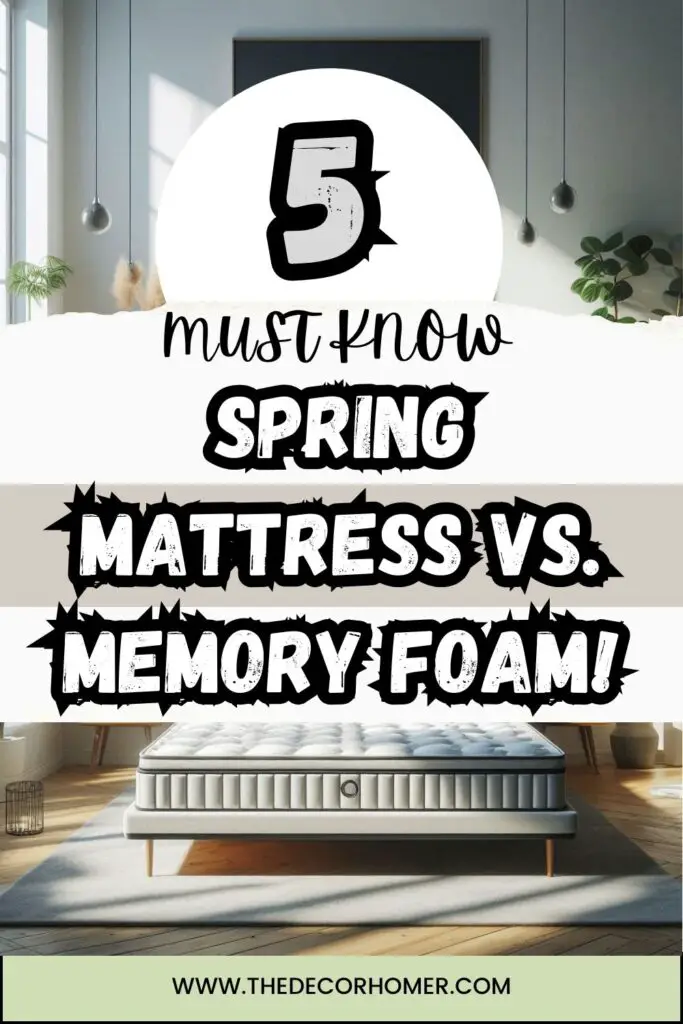5 Must-Know Spring Mattress Vs. Memory Foam!
With hundreds of options in the market, I know it is a pretty daunting task to choose the right mattress.
You need to consider a bunch of things. However, it is no rocket science!
All you need is a bit of a guide. It can help you match your sleeping needs and requirements with ease.
Speaking of 2024, the most common and popular ones are Spring and Foam.
I’m sure you’re considering either of them but confused at the same time.
Well, no worries! By the end of this discussion, you’ll know the type of mattress you want for yourself.
Keep scrolling to know more…

What is a Spring Mattress?
They are made out of steel or metal coils (or springs).
Then, these are coated in layers of various soft materials for comfort and additional support. That’s how you get a spring mattress.
There are four different coil variants used to provide different amounts of support: continuous, Bonnel, offset, and pocket.
While pocket coils are separately wrapped, “innerspring” coils are often joined.
Generally speaking, spring mattresses are considered to be the more “traditional” style of mattress.
However, the spring mattresses of today are very different from the ones your grandparents used to sleep in.
Spring Mattresses: Back Story
In case you’ve ever wondered, spring mattresses were invented in 1871 by Heinrich Westphal. They have dominated the market for nearly a century.
Though spring mattresses have evolved a lot since the 19th century, the coil support mechanism is still the same in 2024.
New mattress technology has improved the comfort and longevity of these mattresses in addition to the coils.
Since it is very affordable, spring beds still remain popular to this date.
Some brands also use the word “innerspring technology” to refer to mattresses that include springs and foam, like hybrid mattresses.
Hybrids combine supportive innerspring with soft memory foam to give you the best of both worlds.
Pros of Spring mattresses
- Spring mattresses require less break-in time.
- Given that there is ventilation between the spring coils, spring mattresses are cooler to sleep on than other foam mattresses.
- In contrast to memory foam’s “sinking” and contouring sensation, coils deliver a bouncing and “responsive” experience.
- They are affordable compared to any other type of mattress.
- Since memory foam mattresses are denser, you may enjoy the weight distribution and feel of an innerspring system.
- You can adjust the firmness depending on your weight or support requirements.
- Pocketed coils don’t retain body heat and facilitate less motion transfer.
Cons of a Spring Mattress
- Some types may increase your body aches rather than relieve them if the proper comfort layers aren’t there.
- Memory foam mattresses often last longer and come with better warranties than spring mattresses.
How long does a spring mattress last?
These mattresses normally last 7 to 10 years.
But this depends on the general design of your mattress and how you maintain it.
Generally speaking, after years of your body pressing on the springs, some parts will start to droop and bend.
The coils in high-quality spring beds are often thicker and may last longer.
What is a Memory Foam all about?
Multiple soft polyurethane or polyol foam layers make up the very popular memory foam mattress.
The thickness of the foam layers often varies, providing the ideal base for a contouring sensation and uniformly dispersed support.
Because of this, most people admit that sleeping on a memory foam mattress is more pleasant than on a conventional spring mattress.
Memory Foam: Back Story
Interestingly, in the 1960s, memory foam was initially conceptualized for astronauts!
The first prototype was developed by NASA to assist astronauts in coping with the pressure they encountered in the space.
In 1991, numerous brands began using this foam in their mattresses when NASA disclosed the formula.
These mattresses were initially only utilized in hospitals due to their exceptional capacity to offer pressure-free support.
But memory foam swiftly established itself as a staple in the mattress sector.
Memory foam beds have some of the greatest customer satisfaction rates, particularly among people who have back problems.
The major drawback of memory foam mattresses when they first started to gain popularity was their ability to trap your body heat.
Not the best option for warm sleepers!
Fortunately, this is no longer an issue thanks to the development of gel memory foam.
By absorbing heat, the gel foam keeps you cool all night.
Pros of Memory Foam
- Memory foam aids in effectively distributing your body weight. It supports each pressure point to ease aches and pains to give you a restful night’s sleep.
- Memory foam mattresses may draw heat away from you as you sleep. It is apparently more if they are loaded with cooling agents like gel and other materials.
- Memory foam mattresses maintain their form longer than spring mattresses. So, there are no concerns about future drooping.
- The layers of memory foam mattresses may vary in hardness based on the overall layers, contrary to popular belief that foam is very soft. This allows for the creation of an ideal sleeping surface that adapts to and supports your body.
Cons of Memory Foam
- Depending on the materials used, some conventional (non-gel) foam may retain heat.
- You would need to replace the mattress sooner than you anticipated if the foam isn’t of good quality and durability.
How long does memory foam last?
A memory foam mattress has a lifespan of 9 to 12 years, maybe even longer.
The durability will rely on the quality of the components and how well you care for your mattress, much like a spring mattress.
For maximum durability and performance, you can put your memory foam mattress on a sturdy base or foundation and rotate it every few months.
Final Verdict: Spring vs Foam Mattresses
It’s an open secret that the highest customer stratification ratings are generally seen with memory foam mattresses.
It is because of its capacity to offer support and pressure reduction.
However, your taste and preferences will determine the best kind of bed for you.
When choosing a new mattress, you should take your sleeping position into account, as well as any health concerns.
Spend some time researching a little more to cross-check if it fulfils your needs.

